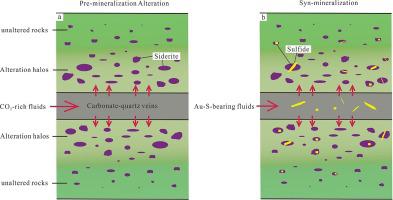Ore Geology Reviews ( IF 3.2 ) Pub Date : 2021-09-21 , DOI: 10.1016/j.oregeorev.2021.104479 Wen Ma 1, 2 , Teng Deng 1, 2, 3 , Deru Xu 1, 2, 3 , Guoxiang Chi 4 , Zenghua Li 1, 2, 3 , Yueqiang Zhou 5 , Guojun Dong 5 , Zhilin Wang 6 , Shaohao Zou 1 , Qian Qian 2 , Shichao Guo 2

|
Hydrothermal alteration commonly occurs in lode gold deposits, and contributes to metal precipitation through water–rock interactions. In the Wangu gold deposit in northeastern Hunan, South China, bleaching of slates enclosing auriferous quartz veins widespreadly occur, with the colour transformed from dark-grey into pale yellow-grey. The bleaching has been used to guide gold exploration, but its nature and genesis, as well as the relationship with gold mineralization, remains unclear. Field and petrographic work, combined with Tescan Integrated Mineral Analyzer (TIMA), demonstrates that the bleaching is mainly caused by the combination of sericitization and carbonatization. Combined with fluid inclusion studies, it is inferred that bleaching is caused by the pre-ore hydrothermal event characterized with CO2-bearing fluids. Large amounts of siderite are distributed within the bleaching zones, and they are locally crosscut by sulfides, suggesting that the bleaching happened before gold mineralization. Mass balance calculation and μ-XRF analysis indicate that despite the abundance of siderite, Fe is not gained during alteration. Geochemical path modeling further suggests that siderite is efficient in precipitating Au by decreasing S contents in fluids and destroying Au-bearing complexes. In addition, the siderite contents in altered slates and Au contents in sulfides suggest that the chemical interaction between siderite and ore fluids can produce ores with economic significance. The siderite developed during the pre-mineralization alteration, provided ideal chemical traps and prepared the ground for gold mineralization. When the gold-bearing fluids overprinted the altered rocks, sulfides formed through reaction with siderite. It is concluded that the sulfidation, which resulted in the destruction of Au-S complexes, is the major mechanism for gold mineralization within the bleached slates.
中文翻译:

江南造山带中部万古矿床热液蚀变地质地球化学特征及金成矿意义
热液蚀变通常发生在矿脉金矿床中,并通过水-岩相互作用促进金属沉淀。华南湘东北万古金矿床中,广泛发生包围含金石英脉的板岩白化现象,颜色由深灰色转为淡黄灰色。漂白已被用于指导金矿勘探,但其性质和成因以及与金矿化的关系仍不清楚。现场和岩相工作,结合 Tescan Integrated Mineral Analyzer (TIMA),表明漂白主要是由绢云母化和碳酸盐化的结合引起的。结合流体包裹体研究,推断白化是由以CO 2 为特征的矿前热液事件引起的- 轴承流体。大量菱铁矿分布在白化带内,局部被硫化物横切,表明白化发生在金矿化之前。质量平衡计算和μ-XRF分析表明,尽管菱铁矿丰富,但在蚀变过程中并没有获得 Fe。地球化学路径模型进一步表明菱铁矿通过降低流体中的 S 含量和破坏含 Au 的复合物而有效地沉淀 Au。此外,蚀变板岩中的菱铁矿含量和硫化物中的金含量表明菱铁矿与矿液之间的化学相互作用可以生产具有经济意义的矿石。菱铁矿在矿化前蚀变中发育,提供了理想的化学圈闭,为金矿化奠定了基础。当含金流体覆盖蚀变岩石时,通过与菱铁矿反应形成硫化物。得出的结论是,导致 Au-S 配合物破坏的硫化作用,











































 京公网安备 11010802027423号
京公网安备 11010802027423号